Listed 100 (total found 192) sub titles with search on: Main pages for wider area of: "MAKEDONIA CENTRAL Region GREECE" .
ADENDRO (Village) THESSALONIKI
Tel: +30 23910 31208, 32020
AGIA PARASKEVI (Village) HALKIDIKI
Tel: +30 23740 61439
Fax: +30 23740 61439
The village of Agia Paraskevi is located in the inner land of Kassandra
Peninsula and the surrounded by pineforest.
Wander in the narrow alleys of the village.
The residents of the village are simple and hospitable and their main
occupation is the cultivation of olive trees and apiculture.
AGIOS CHRISTOFOROS (Village) SERRES
Tel: +30 23240 20136

AGIOS GEORGIOS (Village) GIANNITSA
Tel: +30 23810 61127
Agios Georgios is the smallest village of the municipality of Alexander
the Great with 321 residents according to the census of 1991. It is 20 km away
from Giannitsa and 30
km from Edessa. The residents
deal with the stockbreeding and agriculture. The most important cultivations are
peaches and asparagus. The village has been built around its square, where there
is the new two-storied building of the community bureau and the war memorial.
The square is surrounded by very tall pine trees and grass planted
gardens. Agios Georgios is the first village in the municipality, where have been
placed mail boxes in front of the community bureau. In the same building there
is the community clinic while behind it there are the Primary school and the Kindergarden.
Across the road there is the old and beautiful church of Saint Dimitrios. Both
the church and the village have great history, which goes back in the beginning
of the 19th century.
In the north-west part of the village, on the way to Liparo
there is the Agricultural corporation and the football field of the team P.A.O.K.
of Agios Georgios. The Cultural Association "Alexander the Great" is
also activated in the village. There is great interest for the unexplored, up
today, hills which are outside of the village. It is speculated that at their
basis there are hidden tombs of the Hellenistic Era. There is also a lot of green
and many trees in the area, as well as the local refreshment stand. Altogether,
they create an artificial paradise, perfect place for resting and excursions.
AGIOS MAMAS (Village) HALKIDIKI
Tel: +30 23730 91201, 91706
Fax: +30 23730 91731
Agios Mamas is a village
with a population of 1342 inhabitants, located between the Kassandra and the Sithonia
peninsulas.
Its waterfront settlements "Portes", "Varkes" and "Gremia", located
towards Thermaikos Bay, include the largest hotels and Municipal camping sites.
There are new holiday settlements that are currently under development
at Agios Mamas beaches on the Toroneos Bay side.
The village is famous throughout Greece for its "Agios Mamas trade
fair", a pole of attraction for thousands of visitors in early September.
History:
The oldest known organized settlement in the area of Agios Mamas was
located in the hillock of the same name (where there are currently excavations
taking place) and had been in existence since as early as 5000 BC.
However, the oldest known records attesting to the existence of the
village - with its current name, what is more - are Mount Athos documents of 1047
BC.
In 1423 the Ottomans subjugated Agios Mamas. In the mid-15th century
the village belonged to an Ottoman ruler (Michael Bei). In 1821 the inhabitants
of the village played an active part in the Greek revolution. The first known
historical attestation to the trade and cattle fair dates back to 1870.
The village took its name from Agios
Mamas.
AGIOS PANTELEIMON (Village) HALKIDIKI
Tel: +30 23730 21215
Fax: +30 23730 21215
Agios Panteleimonas is a picturesque agricultural village of 452 inhabitants,
whose normal occupation is agriculture.
In the village, with its abundance of running waters and plane trees,
nature is encountered at its most unspoiled state.
History:
Agios Panteleimonas was built in 1923 by refugees from Prikonisos
of Propontis.
AGIOS PRODROMOS (Village) HALKIDIKI
Tel: +30 23710 96222
Fax: +30 23710 71273
AGRA (Lake) PELLA
At a short distance from Edessa, Lake Agra-Nisiou-Vritton is situated. The
lake was artificially created during the 50s to cover the needs in water of a
small hydroelectric power plant of the Public Electricity Board, but rapidly developed
into an area with particular ecological interest, since it hosts and supports
a great number of bird species. The wet meadows, the aquatic vegetation and the
water create in the area of springs a unique natural scenery, while the agricultural
landscape is dominated by apple and cherry cultivations, which gives rise to the
organization of local festivities and fairs.
This text (extract) is cited October 2003 from the Pella
Prefecture Tourism Committee tourist pamphlet.
AGROSYKIA (Village) GIANNITSA
Tel: +30 23820 93349
Legend has it that the name of the village of Agrossikia originated
from the wild fig trees that smothered the area.
The village's inhabitants are by and large of Pontos origin since
the older inhabitants had pretty much moved from surrounding areas. The refugees
arrived periodically since 1934 from the areas of Pontos, Sevastia, the town of
Charsera in Argiroupolis and Farassa of Kessaria. The reason they decided to built
their new home here is the similarity of the landscape with that of the land the
left behind. They carried nothing but their memories and the icons of their Saints,
some of which are still kept in the church of St. Ioannis Chrisostomos in the
center of the village. The three cultural clubs connected with the inhabitant's
origin of St. George Chalinaras, the Cultural Club and the Farassotes Club have
undertaken the higher duty to preserve the rich cultural tradition of their ancestors.
Agrossikia
is built in a picturesque landscape of unique natural beauty and is an excellent
recreation area.
On the evergreen hill of Profitis Ilias, where a celebration is held
every year with opulent events, the visitor can enjoy the uniquely beautiful landscape.
The Dam lake pops up first in front of the highlands of Paikos mountain. The hill
with the ruins of the ancient castle of Pelitis is witness to human presence in
the area from ancient times.
ALOROS (Village) PELLA
Tel: +30 23840 92366
Aloros is one of the older villages of our municipality. It is built
near an ancient settlement,next to the place that ruins of ancient fortress are
found,a place called ancient Evropos,
ast the historians say.
It is southern of Aridea,
next to the road to Edessa
and Thessalonica, it is built
in the fringes of a hill with church of Saint George on the top, that is built
by the refugees residents that came, in 1922, from the region of Nikopoli of Pontos.
From 1960 and afterwards the majority of residents immigrated in the
centre and in big cities in Greece. Today has 550 residents and deal mainly with
the agriculture. Fruiterer trees (peaches, pears, apples and other), vines, asparaguses
are cultivated. The church of Saint Nikolaos, in the square of the village, celebrates
on 6 December. In the village exists the church of Saint George above the hill,
the chapel of Saint Hristoforos and the church of Saint Theodoros with a very
old temple.
AMMOULIANI (Island) HALKIDIKI
Tel: +30 23770 51208
Fax: +30 23770 51108
Ammouliani is the only inhabited island with a permanent population (approx 600
residents) in Halkidiki. It is situated in the gulf of Mount
Athos, at a distance of approx.130 kilometres from Thessaloniki
and is connected to the mainland with a ferry boat service with the opposite coast
of Tripiti. The itineraries
of the boats are in regular time intervals throughout the day. It has an extent
of 4,5 kilometres. There are lots of hills and small valleys on the island which
have blended in with the olive trees and low vegetation but there are no systematic
cultures so the ecosystem remains untouched. The coasts present a variety of small
shaped creeks with splendid sandy beaches. Weather conditions are not characterized
by intense and we should remark that although an island, there are no strong winds
especially during the summertime.The residents occupy themselves mainly with fishing
and tourism.
ANASTASSIA (Village) SERRES
APSALOS (Village) PELLA
Tel: +30 23840 65201
Apsalos, with 1054 residents, is found in a distance of 11 kilometres
from Aridea, in the road
to the Edessa and Thessalonica.
Built in the entry of province of Almopia, it is the first municipal
department that the visitor meet coming from Thessalonica and Edessa.
The history of Apsalos is lost in depths of centuries. According to
the Claudius the Ptolemaist (geographer of 2nd century ) Apsalos is considered
as one of the ancient cities of Almopia with Orma,
Evropos (Aloros) Ancient
Apsalos is related with the ancient settlement that is found in the road Apsalos
- Polikarpi,
next to the sources of waters.
The Christian residents of the village came in the period of 1922-34
after the mikrasiatiki(Asia Minor) destruction and the exchange of populations.
They were inhabitants from Pontos, Thraces and Mjkrasja'tes. In 1945 also came
some families vlaxoi.
The native of the Pont residents emigrated from the region of Hatzi'
Osma'n of Nikomidia,
Ak Tag Mate'n province of Ankara and Mpoylga'r Mate'n (mine of Bull) southern
Turkey. Also exist a few families of Pont's inhabitants that came from the region
of Trapezoyntas and
Tohouz.
ARGILOS (Ancient city) SERRES
Founded by the Andrian colonists, west of the estuary of the Styrmon
River in the Archaic period (654 BC), it appears active until the Hellenistic
times after which it declined due to the great radiance of neighbouring Amphipolis.
The excavations of the recent years uncovered parts of a defensive enceinte, private
houses, public buildings and roads of the Archaic and Hellenistic city remarkably
well preserved. Two important tombs of Macedonian type have also been brought
to light, as well as clusters of rectangular tombs of the Classical and Hellenistic
period.
This text (extract) is cited August 2003 from the Prefecture
of Serres tourist pamphlet.
CHALKIDONA (Small town) THESSALONIKI
CHANIOTIS (Village) HALKIDIKI
Tel: +30 23740 53320
Fax: +30 23740 51260
The area is full of springs and greenery.
The wonderful beach of Chanioti attracts thousands of visitors everyday.
There are dozens of alternative choices if you want to have a good
time during both day and night.
Chanioti is also the seat of the Municipality
of Pallini.
CHRYSSOCHORAFA (Village) SERRES
Tel: +30 23250 51345, 51610
DASSOCHORI (Small town) SERRES
Tel: +30 23250 22557
DION (Ancient city) PIERIA
On the foothills of Mt.
Olympos only 5 km. from the Pierian shores, lies the city of ancient Dion.
In an area forgotten until now but provided with inexhaustible natural charm,
extensive archaeological excavations have been conducted by the University
of Thessaloniki to discover the sacred city o the Macedonians.
The Macedonians used to gather at Dion to honor the Olympian gods
with sacrifices and offerings. King Archelaos (414-399 B.C.) brightened these
festivals with athletic and theatrical performances. There Philip II celebrated
his glorious victories. Alexander, starting out his expedition, there sacrificed
to Olympian Zeus and there the famous bronze group by Lysippos, representing the
25 horsemen fallen at the Granikos battle, was erected.
Rich discoveries cast much light on the history of Dion and the history
of the Macedonians in general. Of particular importance were the results of the
study of the religious practices of the ancient Macedonians. The sanctuaries of
the gods, the Greek and Roman theatres and the stadium were found spread over
a large area outside the city walls. This, of course, is not incidental; it undoubtedly
proves that the sanctuaries were used not only by the inhabitants of Dion, but
also served the religious needs of a greater number of people, much in the same
manner as the great central sanctuaries, in the rest of Greece
which, during their festivals, received thousands of visitors. Various pilgrims'
offerings were placed in the sanctuaries of Dion. At the Sanctuary of Olympian
Zeus especially inscriptions were set up referring to important state affairs
such as peace treaties, regulation of boundaries, honorary decrees, etc. The Macedonians
who crowded these festivals could read these texts and be informed.
Investigating the areas of worship led the archaeological pickaxe
to the oldest known holy structures of the Macedonians. They are two small temples
of the "megaron" type that is a building with an open antechamber and
a cella. Various offerings have been found inside these structures, mainly idols,
lamps and vessels made of clay, glass beads etc. Most of the finds belong to the
Classical period and some date as far back as 500 B.C. According to all the evidence
an earth goddess of fertility must have been worshipped there. This hypothesis
was confirmed by an inscription found on a 4th century B.C. vessel referring to
the name of Demeter. The excavations also brought to light finds related to the
worship of other gods, such as a group of statues depicting Asclepius and his
family. Next to the theatre, at the Temple of Dionysos, sculptures, inscriptions
and more structures have been found. From the Sanctuary of Zeus come several inscriptions
and the base of a big statue of King Cassander.
Dion remained hospitable towards foreign gods as well. The worship
o Sarapis and Isis, advocated by the state propaganda of the Ptolemies of Egypt
had arrived there in the Hellenistic period. A Sanctuary of Isis was located in
1978 immediately outside the SE corner of the city walls.
The rare luck of finding this sanctuary intact, just as it fell down
after earthquakes tremors, is due to the mud of floods, which covered it immediately
after the final catastrophe. In this sanctuary the worship of the Egyptian goddess
Isis, as the inscriptions testify, succeeded the worship of Artemis to whom offerings
were found dating from the Hellenistic period. A small temple housed the worship
of another goddess, namely Aphrodite, who had in Dion a particularly characteristic
name: "Hypolympidia", i.e. Aphrodite worshipped below Mt.
Olympos. Ancient Dion was a well laid-out city. An elaborate network of roads
paved during Imperial times, demarcated the housing and allowed the free circulation
of pedestrians and vehicles. Fourteen roads have been located and excavated. The
most impressive of the latter is a complex of public baths that covers an area
of more than 4.000 m2.
This text (extract) is cited October 2003 from the Prefecture
of Pieria tourist pamphlet.
DIONYSSIOU (Village) HALKIDIKI
Tel: +30 23730 21800
Fax: +30 23730 25702
A village with a population of 1303 inhabitants. The residents proliferate
in summertime, when the area is transformed into a tourist resort and the village
itself becomes a retreat for thousands of holidaymakers.
The greatest part of the tourists opts for the
built-up area of the waterfront, which, as it is built alongside Thermaikos
Bay, has a model street plan. What is more, the waterfront area offers the tourist
a spotless beach.
You can spend your day there, enjoying the beach, walking along the
waterfront in the shadow of the trees and finish your day in one of the numerous
small taverns and bars of the area.
History:
Dionyssiou was built in 1923 by the refugees from Eastern
Thrace (Tsanakale area). It originally consisted of the settlement that was built
on a dependency of the Dionyssiou monastery, after which it was named.
The waterfront area was built in 1964. It mainly consists of holiday
homes and tourist lodging.
DOIRANI (Lake) KILKIS
The lake of Dorani is situated in the northern part of Prefecture
of Kilkis and forms a natural border between Greece
and FYROM.
Its crystal clear waters with its therapeutic qualities offer swimming
in summer and fishing all year round, while the Mpelles
Mountain Range is mirrored in its waters.
Everyone who visits Doirani will feel the immense tranquility of the
surroundings. They will also feel an essence of the historical journey through
the centuries and will enjoy the magical sunset with the waters of the lake reflecting
the red colour of the sun as it sinks into it.
Visitors will become acquainted with the unique coastal paths from
the residential area of Doirani
to "Hilia Dedra" then to "The Monument of Nature" with its
perennial oak trees. They will climb the Mpelles
Mountainside searching of the waterfall, the eagle nests and the trails of
the wild boars. In the summer visitors can go surfing and rowing in the lake or
play beach volley and soccer in the sand. They can also attend the cultural events
"DOIRANEION" and "MOURIOTIKON" or the theatrical programs
at the "Forest Theatre" at Drosato.
At the local taverns everyone can sample the fresh water fish "grivadi"
and the meat form locally breed herds. From Doirani
Border Station visitors can cross over to FYROM
and its developed tourist area or they can do their shopping in the "Duty
Free Shop".
If you travel north you will encounter Kerkini
and to the east Krousia and
"Botanical Garden".
This text (extract) is cited October 2003 from the Prefecture
of Kilkis tourist pamphlet.
DOROTHEA (Village) PELLA
Tel: +30 23840 22643
Dorothea has today 650 residents. In a small distance from Dorothea is the settlement
Virtuous, with 80 residents.
The residents are mainly farmers and cattle-breeders. They produce industrial
tomato, leeks and peaches. Outside the village, in asmall distance, is the church
of Saint Paraskevi. In Dorothea you can see old maintained and lived houses that
have been manufactured 10 years ago.

DROSSERO (Village) GIANNITSA
Tel: +30 23810 96167
Drossero is built in a distance of 1.5 Km from Gypsohori, at the foot
of mountain Paiko. The
population is 558 residents according to the census of 1991. Following the left
entrance of the village, we see the building of the Agricultural co-operation
of Drossero, the strongest co-operation of the municipality.
In a distance of 100m, in a big plot there is the two-storey local
building, where there is the Kindergarten. In the past, the first floor was the
guest room. The Kindergarten has one room with a lot of school equipment, capable
to cover the needs of six children of the village and the kindergartener who takes
care of them.
Walking along the road, on the left there is the church of Saint Constantinos
and Saint Eleni. In the center of the village there are gathered all the cafes
and the rest social services. In the two-storey building of the community bureau
there is the veterinary clinic and the community clinic. In the same area there
is the Primary School and the building of the Cultural Association of Drossero
"Philippos". Opposite, there is the building where the Police Station
was sheltered. On the right entrance of the village, in a 200m distance, there
is the football field of the team "Megas Alexandros". In the land of
the community of Drossero, a narrow stripe of forest is included. It covers 9.000
m² at the foot of Paiko mountain.
DYSSORON (Mountain) KILKIS
The low Krousion Mountain Range comprises the natural border between
the prefectures of Kilkis
and Serres. For centuries
now it has held in its heart the gold bearing source "The
river Gallikou". The beautiful variety of fauna reaches the forests with
its beach, pine and oak trees. This is where the wild boars, deer, vultures and
partridges are hidden. The Krousion Botanical Gardens encounter the trails of
nature where visitors can pursue their interests. This is where they can become
lost in the magic of nature up north at Kerkini
or east at Doirani.
The Palatianou
archaeological site and the post-Byzantine churches of "St.
Antoniou", "K. Theodorakion",
"Kokkinias", "Melissourgiou"
and "Fiska" witness
the human trials through many centuries. This was continued by the refugees from
Pontos and Thraki.
There is also "Mpampo" from Terpillo,
"The Momogerous" from St.
Marko and the traditional weddings from Pontos
at Efkarpia and Fiska.
There are also the cultural summers of the Krousson
municipality.
Krousia is a huge open window to nature, a challenging invitation
to everyone who is searching for its caress and attention.
This text (extract) is cited October 2003 from the Prefecture
of Kilkis tourist pamphlet.
DYTIKO (Village) GIANNITSA
Tel: +30 23820 93282
Archaeologists have revealed that the
area of Ditiko has probably been inhabited since prehistoric times.
The first contemporary settlement was named Konikovo, meaning an area
with a lot of horses. In 1922 this area was settled by Pontos refugees, who named
the settlement Stiva, due to the many hayricks there. Later on, and as of 1955,
the community was named Ditiko.
The majority of Ditiko residents are of Pontos origin and are stubborn
in promoting their culture. The club "Ipsilante" operates within the framework
of this notion and organizes the Ipsilantia Events every year. These events include
traditional Pontos song and dance on the day of St. Constantine's celebration.
The Ditiko area, as indicated by historical sources, presents with
significant activity in the Macedonian struggle era. This is the alias Nikoforos
II, was heroically killed in a Turkish ambush.
The church of St. Constantine and St. Helen stands tall and reveals
its internal interesting frescos and holy icons brought here by the ancestors
of Abdouramaliin Pontos.
The Ditiko inhabitants are also very proud of the WRESTLING CLUB established
in1987, which has displayed a very successful and upward course with significant
distinctions. The 40 wrestlers enjoy high morale and confidence and look forward
to the 2004 Olympic Games.
The landscape surrounding Ditiko is of exceptional beauty with rich
sycamore tree vegetation that follows the route of a ravine, an area of recreation
andenjoyment. Thechurch of St. Sofronios stands at the village's entrance giving
visitors a warmand affectionate welcome.
EDESSA (Ancient city) PELLA
The ancient town of Edessa was built on a natural passage. There,
the age-long road axis was renamed to VIA EGNATIA since the 2nd century B.C. The
ancient town in the plain of Loggos was gradually abandoned and habitation occurred
in the upper town in the mountainous Macedonia. This choice was made because of
the waters which were a perfect defensive system and offered fortification.
The oldest finds are from the Neolithic times but the most are from
the copper age and mainly from the iron age. In the 6th - 5th century B.C. ancient
Edessa developed in two levels : the Upper town or Acropolis and the lower town
on Loggos. Nowadays after the excavation parts of the ancient walls parts of buildings
of the Acropolis can be seen as well as the old tombs of various types which are
in the lower town. After 168 B.C. and the conquest by the Romans the town knows
prosperity and has its own mintages made which show the participation of the town
in the retention of the road axis Via Egnatia. A large number of inscriptions
ensure the existence of parliament, a high school, as well as the temple of Dionysus
Pseudanor also the temple dedicated to Goddess Ma, the mother of Gods, other monuments
show the worship of Goddess Artemis and the Phrygian God Savazios.
During the second half of the 3rd century A.D. the town suffered of
numerous raids by Goths. This led to a quick reparation of the ancient wall in
order to make the town more secure.
The inhabitants used buildings material which they took from the neighboring
tomb. Among these is also the anaglyph of ‘the Hog’ that reportedly passed together
with his master the Via Egnatia from Dirachio
to Edessa to take part in the great Macedonian feast of the Phallocrats ( dedicated
to God Dionysus ) During Christian times was the wall strengthened with a new
fortified line in a distance of 6 km next to the old one. In the end of the 6th
beginning of the 7th century the inhabitants gradually abandon the lower town
and inhabitation occurs in the Acropolis which develops into a Byzantine fortress.
The most important monuments of the area are:
The South gate: made with the early fortress art which is described in
ancient handbooks.
The monumental marble-paved road which crossed the town, columns of marble
and built pessaries can be seen at each side. One of the columns there are many
inscriptions of independence.
The fortress of Edessa is one of the best preserved in Macedonia. It was
constructed in 300 B.C. and repetedly repaired. The Acropolis was fortified by
a wall, which now survives to a height of 6m. Parts of it can be seen through
windows beneath apartment buildings.
This text is cited June 2003 from the Municipality of Edessa URL below, which contains images.
ELATOCHORI (Village) PIERIA
Tel: +30 23510 82029
ELEOCHORIA (Village) HALKIDIKI
Tel: +30 23730 71036
Fax: +30 23730 71036
ELEOUSSA (Village) THESSALONIKI
Tel: +30 23910 22160
Fax: +30 23910 22160
FLOGITA (Village) HALKIDIKI
Tel: +30 23730 31378
Fax: +30 23730 31995
Flogita is a waterfront village, built amphitheatrically and overlooking
Thermaikos Bay. It has a population of 1501 inhabitants, which increases to
several thousands in summertime.
Its organized sand beach is embellished with approximately 600 palm
trees. The beach of the village is one of the loveliest and cleanest in the prefecture.
The main occupations of its inhabitants are agriculture and tourism.
History:
Flogita was built by refugees who came to Greece from Cappadocia.
It was in Flogita (Russian monastery dependency) that the
first hospital operated until 1934. The hospital offered hospitalisation to
refugees and local inhabitants of southern Kalamaria.
GALATADES (Small town) GIANNITSA
The village of Galatades is built two kilometers northern of Egnatia
Street, on the road axis of Giannitsa
- Krya Vrysi. It is the
biggest village of the area and the headquarters of the Municipality of Alexander
the Great. Its residents are farmers and it consists the center of the asparagus
production in Greece. At the entrance of the village there is a square dedicated
to Philipimin Gratsios, the man who brought the asparagus plantation in Galatades,
in the early '70s and contributed to the village's progress.
Going through the main road of the village, we pass by the Cultural
Association "Philippos" of Galatades. In the old Town Hall function
the Open Protection Center for the Elderly (KAPI), the Community Clinic and the
Municipal Developing Service (DEAMA). Next to it, is situeted the contemporary
building of the Town Hall, headquarters and heart of the Municipality, where all
the services of the Municipality are sheltered. Behind the Town Hall there are
the Nursery School and the Kindergarten. Going on to the road of Krya Vrysi, we
reach at a park of 50 Km², which has recently been reformed, with paving, plantations
and playground for children. Across the road there is the building of the Primary
School, in the same yard with the Church of Saint Athanasios.
On the right side of the road, there is the football court which is
also used for cultural activities. Within a short distance are situated the installations
of the Agricultural Association of Galatades, one of the most dynamic in the area.
It has ice chambers and sorting out rooms, for trading the asparagus abroad and
the peaches to the local manufacturing units. At the end of the village, on the
right side there is the playfield of the football team "Olympiakos"
of Galatades.
GAREFIO (Village) PELLA
Tel: +30 23840 75460
It is a mountainous settlement that is found in distance of 7 kilometres
from Aridea, in the borders
Greece and former Yugoslavia. The village took his name from the fighter of Macedonian
Fight capten Kostas Garefis.
The residents deal with the agriculture, the livestock-farming and
the forestal exploitations The Greek Macedonian captain Kostas Garefis was given
birth in the village Apple
trees of Pilion and fought for the release of Macedonia in the region of the
lake of Giannitsa. It died in August 1906 in the village Tsernesovo, that was
later renamed to his honour in Garefi.
GIANNITSA (Town) PELLA
Giannitsa, a modern city with an eminent role in the local economy,
which constituted a great economic and military center ever since the fist years
of the Turkish occupation, because of its strategic position. Situated near a
region where the lake of Giannitsa dominated until the 30s, it experienced the
rage of the battle of Giannitsa during the Balkan Wars. "The Black Statue"
in the city's War Memorial is dedicated to the memory of the dozens of people
who died during the battle. After the 30s, the sole water source that was left
in the area is the Loudias River, which stretches across and supplies with water
the fertile plain country that has been revealed by the drainage of the lake of
Giannitsa, whereas in the same time it constitutes a place for sports and recreation,
since a modern Rowing Center has been operating there during the last years.
This text (extract) is cited October 2003 from the Pella
Prefecture Tourism Committee tourist pamphlet.
GOMATI (Village) HALKIDIKI
Tel: +30 23770 41253
Fax: +30 23770 41253
GYPSOCHORI (Settlement) PELLA
Gypsohori is a small village of 428 residents on the way Trifili-Drosero.
Here, life passes so quietly, you think that time has no meaning. It is an old
settlement and its modern history is closely connected with the nearby villages
Trifili and Drosero. Until it became a member of the municipality of Alexander
the Great, it constituted a community with Trifili, which is 2 Km far away.
In the center of the village there is the town square with its gardens
full of flowers and the bus station. Around the town square there are gathered
cafes and taverns. The road on the right side of the town square leads to the
Kindergarten and the Primary School which is built with stones. At the courtyard
of the school there is a playground. At a distance of 100m there is the facility
of the agricultural association and the football field. Opposite, there is the
building that the cultural association "Macedonia" is sheltered. At
the southeast side of the village there are the old and the new church of Saint
Athanassios.
This text is cited May 2005 from the Municipality of Megas Alexandros URL below, which contains image
IERISSOS (Small town) HALKIDIKI
Tel: +30 23770 22216
Fax: +30 23770 22414
Ierissos is the oldest and biggest village of the Municipality with
3118 residents. It is reported by historians as the continuation of ancient Acanthus,
which was a colony of Andros
since the 7th century B.C and an important city of Macedonia. The local residents
deal mainly with fishing and tourism. During the more recent years, important
professional activity related to Mount Athos has also developed.
It constitutes an important harbour for Northern Greece with lots
of fishing activity.The fishes found in the gulf of Ierissos are well known for
their taste throughout all of Greece.
The sandy beaches as well as the live amusement offered in Ierissos
make it a unique place for vacations. The impressive social and cultural activity
of the residents roots go back centuries and a sample of this are the many traditional
songs that remain alive and are still sang up to today.
A lot of associations have been founded with a variety of activities,incuding
the cultural association "Kligenis", the association "Friends of
Environment", and the music association "Acanthus". There are also
lots of professional associations (fishing, trade, builders association etc).
KALA DENDRA (Village) SERRES
Tel: +30 23210 78978
KALIKRATIA (Municipality) HALKIDIKI
Kallikratia is the most recent municipality of the Halkidiki
district. It came about through the fusion of the villages of Nea
Kallikratia, Agios Pavlos
and Nea Iraklia. The municipality
of Kallikratia has 5,480 inhabitants and it is 40 kilometers from Thessaloniki.
The three villages were founded after the uprooting from Asia
Minor in 1922, by people who mainly originated from Kallikratia, Araklia Gialus
in Eastern Thrace (the part
of Turkey that is on the
European continent). They settled in the area of "Stomion", where a
metoche of the Xenophon
Monastery of the Holy Mountain used to be. There are indications that the
area was also inhabited in prehistoric times, but these have not been confirmed.
Excavations here have revealed a burial stele, which was dated to
be of the 5th century B.C. (ca. 440 B.C.), with a pediment on which a relief depicts
a young woman with a dove on her arm. This finding is now kept at the archeological
museum of Thessaloniki.
Also of great archeological interest is the acropolis of Antigonia,
which is near the village of Nea
Gonia. It was built on a site with natural protection by king of Macedonia
Gonata in the year 280 B.C. Its name continued to live through Byzantine times
by the two villages called Ano Antigonia (Upper Antigonia) and Kato Antigonia
(Lower Antigonia). Near N. Kallikratia to the right on the coast is the village
N. Iraklia, also a refugees’ village. Here a relic box was found dated
to the fourth or fifth century with carved representations of the Old and New
Testament on its four sides. (This finding is also kept at the Archeological
Museum of Thessaloniki). The many summer tourists find a place to spend the
night in the hotels or they rent a room. There are plenty of restaurants, taverns,
pastry houses, pubs and disco clubs. In Kallikratia there are offices of ELTA
(National Post) and OTE (Greek Telecom), there are doctors, vets and drugstores,
modern car repair workshops etc. The area is famous for its fruit, its grapes
and its garden products and also for fish products.
If you decide to spend your holidays near the sea, come to visit Kallikratia.
Here your summer days will become an unforgettable period of time. After a pleasant
day, on its beautiful beaches, "night life" begins. For you evening
outgoing there are many and wonderful choices. It is sure there is something suitable
for you too! You can spend the evening with your family, or at a discotec, or
a bar, a restaurant or even a fish tavern and all the other shops next to the
sea, which offer delicious energy.
A summer in Kallikratia is a real source of energy against cities’
cold winters.
This text is cited November 2003 from the Municipality
of Kallikratia tourist pamphlet.
KALITHEA (Village) KASSANDRA
Tel: +30 23740 23364
Fax: +30 23740 24850
Situated 51 km south of Polygyros,
about 90km from Thessaloniki
and currently with some 500 inhabitants, the community was established in 1922
with the influx of refugees from Asia
Minor. Around the mid 8th century BC, a sanctuary dedicated to Dionysus and
the Nymphs was built, but it wasn’t before the 5th century BC only to be
land-filled during Roman occupation; a smaller one was built around the 1st-2nd
century AD, which is when the other structures were also erected. The sanctuary
was subsequently destroyed and a Christian Basilica was devastated and deserted,
and during the 11th century AD a monastery dependency of Aghios
Panteleimon of Mt. Athos was established in the village. It became an independent
community in 1946, which is when it also acquired its present name.
Kallithea is a pole of attraction for thousands of tourists, who came
to enjoy splendid beaches and great archaeological discoveries. Highlights include
the remains of the Doric sanctuary to Zeus Amon, the sanctuary to Dionysus and
the Nymphs, and the small chapel of Aghios Panteleimon with interesting murals.
One of the most sought-after destinations in the beautiful peninsula
of Kassandra (Chalkidiki), where pine-trees fringe a unique sandy coastline,
Kallithea is a modern commercial and cosmopolitan resort that boasts large hotel
complexes and traditional lodgings. Featuring all the necessary installations
required for thoroughly enjoyable and entertaining holidays, and blessed by its
natural and historic heritage, Kallithea satisfies even the most discerning visitor
and has a spectacular night-life to prove it.
Ideally situated, Kallithea is without a doubt the most suitable base
for day-trips throughout the entire peninsula, particularly for those wishing
to visit the area’s impressive archaeological and historic sights, experience
the lifestyle in some of its traditional and remote villages, and witness some
of the country’s leading timeless destinations.
This text is cited November 2003 from the Community
of Kallithea tourist pamphlet.
KALOCHORI (Small town) THESSALONIKI
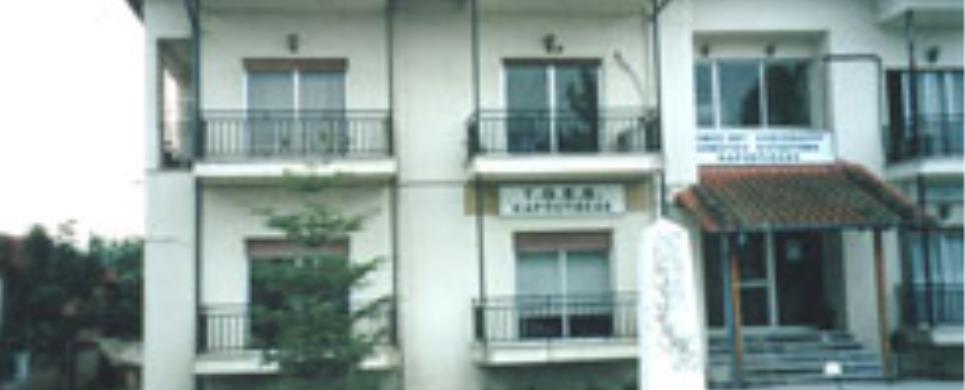
KARIOTISSA (Small town) GIANNITSA
Tel: +30 23820 41333
The village of Kariotissa with population 2,087 residents (census
1991) was the greater village of the Pella Prefecture. However, the last few years
the population reduces. It is situated in the northeastern edge of the municipality
of Alexander the Great and it is 7 Km away from Giannitsa. The distance from Thessaloniki
is 58Km and from Edessa 48Km. The Egnatia Via, the main road axis Thessaloniki-Edessa,
goes through the village. On the southern side of Egnatia Via, in the center of
the village, it is situated its square, with grass planted gardens and trees.
Cafeterias, restaurants, cafes, taverns and every kind of shop are interspersed
along the road, offering to the travelers an ideal place for resting and supply.
In the square rises the two-storey building of the community bureau,
of which in the ground floor are sheltered the community clinic and TOEB-s offices.
At its side, there is the building where the Police Station of Kariotissa was
sheltered till a few years ago, and the building of the cultural association "Akrites".
Across the way, there is the Post Office and in the end of the square, under the
shadow of a plane-tree, there is the taxi station. At the entrance of the village
we see the Pilot High School of Kariotissa, with a remarkable library, and a little
farther the chapel of Agia Paraskevi. The road at the left leads to the Municipal
Stadium of Kariotissa, playground of the football team AEK of Kariotissa. The
church of the Assumption of the Virgin and the Primary School are situated a few
meters southern of the main road. The well laid out streets of the village cause
a sensation to visitors, who characteristically say "there everything is
flat and the streets are vertical between them".
KILKIS (Prefecture) GREECE
Kilkis lies in Central
Macedonia; it has a population of some 82,000 residents.
The gateway to Northern Greece, it has two road border stations linking
the country with Europe (Evzoni
and Doirani) and one rail
entry-exit point (Eidomeni).
It shares borders to the north with Yugoslavia, to the east with Serres
Prefecture, to the south with Thessaloniki
Prefecture, and to the west with Pella
Prefecture.
The plain of Kilkis, which is part of the Central Macedonian plain,
is limited to the west by Mt.
Paikos, to the northeast by the Kerkini
(Belles) mountains and to the east by Mt.
Krousia.
The Axios river
runs through the western section of the district, the Gallikos,
the gold-bearing Exedoros river of antiquity, the southwest portion.
The region also boasts two lakes: Doirani
on the Greek-Yugoslav border and Pikrolimni
where Thessaloniki and Kilkis
prefectures meet.
Large expanses of the region are covered by forests of willows, oaks
and pines, as well as rarer species of plants and flowers. The climate is continental
with cold winters and hot summers. The economy is based primarily on agriculture,
the most important corps being grains - wheat and maize, and to a lesser extent
barley and rye.
Fields of sunflowers, cotton, tobacco and clover are also common.
The areas of Goumenissa and
Mouries are notable for their
garden vegetables, fruit (especially apples and peaches), almonds, hazelnuts and
grapes. The wines of Goumenissa
are of the highest quality and bear the label "d’ origine controlée".
This text (extract) is cited October 2003 from the Greek
National Tourist Organization tourist pamphlet (1992).
KRINI (Village) HALKIDIKI
Tel: +30 23730 73233
Fax: +30 23730 73233
LIMNOCHORI (Village) SERRES
Tel: +30 23250 51205

LIPARO (Village) GIANNITSA
Tel: +30 23810 61228
Liparo is situated in a flat area among the villages Kalivia
- Agios Georgios
- Galatades - Aspro
- Esovalta. It
is 10m above sea level and according to the 1991 census, it has 550 residents.
The distance from Giannitsa
is 18 Km and from Edessa
25 Km. The village has a very important history and two churches of which, the
one dates back to 606 A.D. In 29 of August the village celebrates the decapitation
of John the Baptist organizing a festival and cultural demonstrations.
The main occupation of the residents is the cultivation of asparagus,
peaches and vegetables in greenhouses. Some residents deal with the stockbreeding.
Liparo has a good street plan, which was designed in 1935. Along the main floodlighted
street with the traffic island, are gathered all the services of the village.
In the building of the community bureau are gathered the services of the Agricultural
Co-operation, the Agricultural Association and the community clinic.
Across the road there is the municipal refreshment stand. In a short
distance there are the church of Apostle Paul, the Primary School and the Kindergarten.
Near the village, on the way to Galatades, there is the building of the State
Vehicle Checking (KTEO) which is the only one in Pella Prefecture. On the west
side of the village, on the way to Aspro, is situated the playground of the football
team Aris of Liparo.
LITHOTOPOS (Village) SERRES
Tel: +30 23250 41205
LOFISKOS (Village) THESSALONIKI
Tel: +30 23950 51250
LOUDIAS (Village) THESSALONIKI
LOUTRA ARIDEAS (Settlement) PELLA
The traditional village
of Loutraki is situated in the north of the Prefecture
of Pella and at a distance of 38 km from Edessa,
and the Iamatica Loutra of Loutraki (thermal baths ) are situated three kilometers
farther.
The value of the local thermal springs seems to have been greatly
appreciated even since the Roman years, yet in the middle of the last century
the first water analyses were made and the water's healing qualities were certified.
The thermal springs gush from the riverbed of Agios Nikolaos, with
a temperature that rises up to 37° C. Their large supply (65 cubic meters/hour)
creates the excellent conditions for the operation of the hydrotherapeutic places
of the district, while the open pool and the "little lakes" that have
been naturally developed in the bed of the hot water river, give the chance of
bathing in an imaginary natural scenery.
During the last years, the number of younger visitors that come to
enjoy short vacations in this picturesque district of Greece
and make the best of the opportunities for relaxation and recreation offered in
the district has been gradually rising.
Even during the winter, there are many people who attempt, after having
ascended on the neighboring Voras
Ski Resort, a visit to Loutra and a bath in the open pool, in the occult atmosphere
created by the mist caused by the difference in water and air temperature.
Besides thermalism, there are many other reasons that make this picturesque
spa town worth visiting. Here dominates the impressive "Ramno Bor" (Isso
Pefko) gorge lending the scenery an attractively wild appearance and offering
unique opportunities for an escape in the nature.
This text (extract) is cited October 2003 from the Pella
Prefecture Tourism Committee tourist pamphlet.
LOUTRAKI (Village) PELLA
Tel: +30 23840 91213, 91170-3
Loutraki is a village with 1.280 residents. From 1992 toyrism started
to be developed and today they are hundred hotels that can entertain the visitors.
There are also a lot of modern hotels, restaurants, spaces of amusement and other
shops for the service.
The Spa,13 kms from Aridea,
the capital of Municipality, 20 kms from the ski center and 100 kms from Thessalonica.
In the place of the Spa and in Loutraki, there are hotels and apartments. Also,
there are a lot of shops for the service of visitors, restaurants, refreshment
stands, traditional cafes.
The visitors combine spa' waters with a line from activities as the
walks in the ecological paths and in the gorge of Baths, the mountaineering, the
ascension, the exploration in the caverns of region of Baths and the visit in
the ski center of Voras.
LYKOSTOMO (Village) PELLA
Tel: +30 23840 91320
The current name of the village emanated from a stream that goes down
from the mountain, reaches as the village and resembles with the mouth of wolf.
The settlement Stroumpino was named in Likostomo in 1926 and in 1929 was recognized
as a community with 684 residents. Today it has 368 residents and the biggest
birthrate in the region according to estimates.
Likostomo is an oasis of peacefulness, natural beauty and mental calm,
a laboratory of creation for people of all ages. The climate of the village is
marvelous. The mountain in the embrace of which is built Likostomo resembles with
a painting. The "old Outpost" little outside from the village accepts
visits all the time.
MAVROLOFOS (Village) SERRES
Tel: +30 23240 51838
MEGALI PANAGIA (Small town) HALKIDIKI
MEGAPLATANOS (Village) PELLA
Tel: +30 23840 94195
Fax: +30 23840 94500
Village of province of Almopia that are found near the villages Polikarpi
and Orma.
In Megaplatanos belongs the settlement Monastiraki. Today many people of Megaplatanos
live and work in Canada, Germany and Australia.
Cultural events are each year in the village on 20 September on the
day of the feast of Saint Efstathios. A beautiful settlement is Monastiraki.
Many of its residents live today in other big cities and particularly
in Athens. All however
have their houses in the village, that they visit very often and particularly
the summertime on 15 August when becomes the local festival with a lot of people.
Characteristic of the village, is the best quality of fruits.
More and detailed information, as well as many photos, there are on www.megaplatanos.com , which isn't the community's official website, but is run by private initiative.
MESSORACHI (Village) SERRES
Tel: +30 23240 20140
METAMORFOSSI (Village) HALKIDIKI
Tel: +30 23750 61276
Fax: +30 23750 61276
Metamorfosis is a beautiful, all green, touristic village, it is located
near Sithonia and it is built next to the sea with a very good town plan.
The citizens are immigrants from the Asia Minor, very hospitable and
kind and always ready to offer their valuable services to the local and the foreign
tourists.
It is probably one of the most beautiful villages in the Northern
Greece. It is located on a verdurous slope of a hill, full of old pines and next
to the sea. Its golden beaches, the very clean deep blue sea and the delicate
shores made it very well known all over Greece and Europe. The perfect orientation
grants the area one of the best climates in Greece - cool summer, mild winter
with almost no humidity.
That's why the fact that the Ministry of Education chose the area
in 1950 for the first summer camp is not at all coincidental. The summer camp
is still operating.
MIKRO MONASTIRI (Small town) THESSALONIKI
Tel: +30 23910 61108
Fax: +30 23910 61444

MIKRO SOULI (Village) SERRES
Tel: +30 23240 71779
MONI AGIAS ANASTASSIAS FARMAKOLYTRIAS (Monastery) HALKIDIKI
The monastery of Agia Anastasia Farmakolytria (St Anastasia the Curer) stands
near Vassilika of Thessaloniki, at the foot of Adrianos, one of Mount Hortiatis's
summits. It is said to have been founded by Leon the 6th in the 19th century,
but this has not been cross-checked. In all probability, it was built in 1522
by St Theonas, who later became metropolitan bishop of Thessaloniki. During the
Turkish domination, the monastery owned many acres of land but it was destroyed
by the Turks during the Greek War of Independence of 1821 and was rebuilt from
scratch in 1830. Today, it belongs to the Ecumenical Patriarchate of Constantinople
and honours St Anastasia on the 22nd of December.


MONI AGIOU DIONYSSIOU (Monastery) PIERIA
Tel: +30 23520 84220
The monastery of St. Dionyssios is located on Mt.
Olympus at an altitude of 900 m, and is 18 km from Litochoro.
It is built at a naturally fortified position between two small streams, which
become on - the Enipeas. Today, the Monastery can be reached through a detour
in the forest road, concluding at Prionia, where the climb for the highest peak
of Mt. Olympus begins.
According to historical sources, the Monastery was founded in the
first half of the 16th century by Saint Dionyssios, and was dedicated to the Holy
Trinity. During its 400 years of existence, it constituted a strong religious
and economic power in the area. The Monastery owned forestland, lumber facilities,
water-mills, flour-mills and animals. Since the beginning of our century, it has
not been operating properly, with a total of only 7 monks. However, the Monastery
was very popular with the natives of Central
and Western Macedonia, as
a place of worship, as well as to the mountain climbers.
In 1943 it was considered by the Germans to be the base of the resistance
groups of the area, which was the reason why they destroyed it both by means of
bombing and detonation. Since then, the new Monastery has been based in Metochi,
the existence of which is evident since 1953 under the name "Skala",
near Litochoro.
The worship of Saint Dionyssios, its founder, to whom miracles have
been attributed, as well as its privileged opposition on the mountain of the gods
of Greek Mythology assign, to the monastery a uniqueness by which it attracts
many Greek and foreign visitors.
(text: Dionysia Tsirou)
This text (extract) is cited October 2003 from the Prefecture
of Pieria - Municipality
of Litochoron tourist pamphlet.
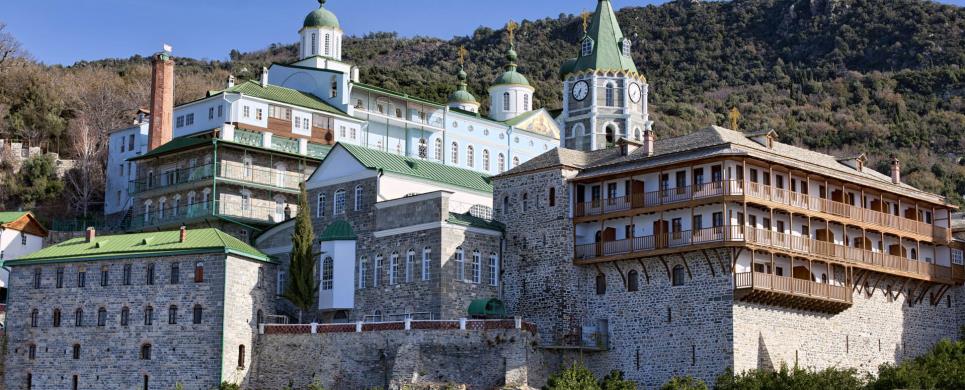
MONI AGIOU PANTELEIMONOS (Monastery) AGION OROS
Tel: +30 23770 23252, 23201
The monastery is built in a bay near the Xenophontos monastery, from
the side of Siggitikos and is dedicated to its namesake Saint. It gives the impression
of a small city with its many-stored buildings and the churches' tall cupolas.
The Katholicon is built in the early 19th c. and its frescoes are typical of the
russian art. The monastery has 15 chapels and 5 kellia, 2 of them at Karyes. The
monastery also owns the Chromitsa metochion, the Bogoroditsa (or the Carpenter's)
Skete, the Nea Thebais or Gournoskete and Paleomonastiro.
In the 13th c. the monastery is burnt and rebuilt with the financial
support of the emperor Andronicus II Paleologus and Serbian rulers. The monastery
knows alternatively periods of prosperity and great misery. The monks are Greek
and Russian, which outnumber the first after 1497. In the 18th c. the monastery
is again in greek hands, only to fall back to the Russians in 1875.
In the monastery there are many portable icons, heirlooms and liturgical
vestments. The library contains 1320 greek and 600 slavic manuscripts and over
20,000 greek and russian books.
The monastery in inhabited by a brotherhood of 40 monks.
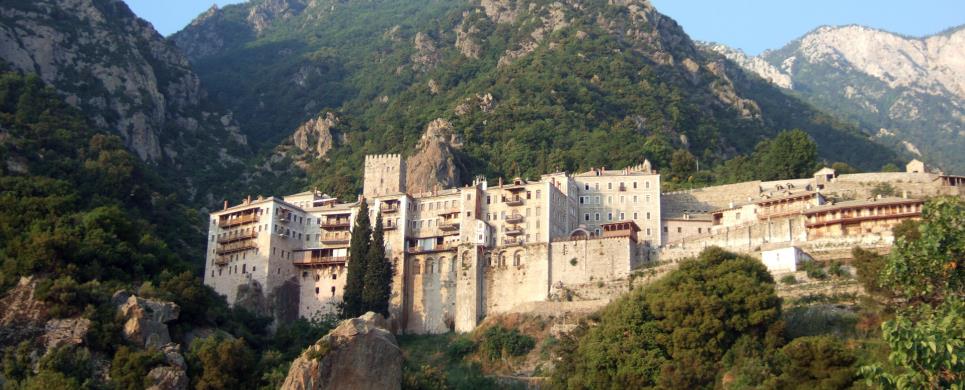
MONI AGIOU PAVLOU (Monastery) AGION OROS
Tel: +30 23770 23250, 23609, 23741-4, 23355
Fax: +30 23770 23355
It is situated in the west foot of Athos, 20 min from the sea and
is dedicated in the Presentation of Christ to the temple. The monastery was destroyed
many times by various causes, and its buildings belong to different periods. The
Katholicon was built shortly before the mid 10th c. The monastery has 12 chapels,
the most important of which is that of St George, with frescoes of the Cretan
School (1555). The monastery also possesses the Nea Skete and the Skete of St
Demetrius.
The monastery is mentioned for the first time, in the mid 10th c.,
mostly its founder Pavlos Xeropotaminos, and then in 1259. After the Catalan raids,
it is degraded into a kellion, only to become a monastery again in the 3rd quarter
of the 14th c. In the 15th c. it is financially supported by Serbians rulers and
after the fall of Byzantium, by rulers of eastern Europe.
Among the monastery's possessions, are counted portable icons, heirlooms,
holy relics and liturgical vessels.
The library contains 494 manuscripts and about 12,500 books.
The monastery is inhabited by a brotherhood of 30 monks.

MONI CHELANDARIOU (Monastery) AGION OROS
Tel: +30 23770 23281, 23797, 23494, 23108
Fax: +30 23770 23494
The history of the monastery begins in the 10th century but, after
its ruin, the emperor Alexius III, in 1198 granted it to the Serbian rulers Stefan
Nemanja and his son Rastko, who became monks (Symeon and Sava respectively) who
proseeded to the construction of new buildings. During the 14th century, the monastery
reached its highest peak, accumulating riches and heirlooms from imperial as well
as private donnations.
One of the largest and richest in heirlooms monasteries of the Holy
Mountain, Chelandar is the main spiritual center of the Serbs from the 12th century
onwards. Besides the central church (Katholicon), honoured in the memory of the
Presentation of the Virgin, there are many chapels, the refectory and the aisles
with the monks΄ cells as well as the other auxiliary buildings (guest-house, library
and others).
The present monastic community preserves close relations with the
Serbian people as well as the Greek population of the Holy Mountain and its neighbouring
area.
Apart from the abundance of frescoes (St. George΄s Tower, Katholicon,
old and new Refectory etc), the monastery possesses one of the largest libraries
of Slavonic and Greek manuscripts, as well as a large number of portable icons
dated in the 12th century onwards.
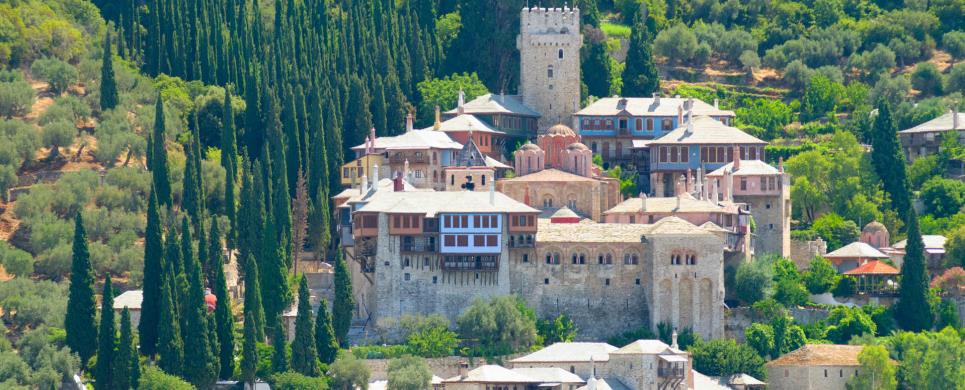
MONI DOCHIARIOU (Monastery) AGION OROS
Tel: +30 23770 23245
It is one of the most elegant and beautiful monasteries of the Holy Mountain, sited by the sea. One sees first the Refectoty (old and new) and ends at the uppermost
point on a high tower which dominates the place. The Katholikon, which is equally
high, has been built over the walls of the older church.
The monastery was founded during the second half of the 10th century;
its foundation is attributed to Euthymios, a pupil of Saint Athanasius of the
Great Lavra, who had the service of the "Docheion" (vessel), which gave the name
to the monastery. The Katholicon and the Refectory were built and decorated with
frescoes in the mid 16th century (1568). The wall-paintings of the Refectory are
dated in 1675 and in 1700 (the northern part).
Apart from the 16th century frescoes in the Katholicon, there are
also important frescoes of the 18th century in the exonarthex, which are excellent
copy of the 14th century from other monuments. Equally remarkable is also the
library of the monastery, where one can find, apart from the most important historic
monuments, abour 900 manuscripts.
The monastery is inhabited by a very active group of monks who take
care of its various needs -especially the hospitality to pilgrims and scholars.
MONI EIKOSSIFONISSIS (Monastery) SERRES
In a steep ravine of Paggeo Mountain there is the Holy Monastery of Icosifinissa in luxuriant and immaculate forests, where a mysterious silence reigns and is interrupted only by the whisper and the chirping of the birds. The Monastery has great historical value for many hundreds of years and it is commemorated in the name of the Virgin Mary, whose icon, not made by human hand, is kept there, painted from time immemorial and attracts the christians from all over Macedonia. The repartee of the Monastery's name, according to one version, comes from the word "είκοσι φοίνικες" (twenty phoenix). According to another version Germanos, the first founder, who showed despair about the water shortage problem and was thinking of building the Monastery in a different place, he had a vision, in which the Virgin Mary sent a blackbird (cossyfon), which discovered water between copius bushes.
From that moment onwards the Monastery was named Cossyphinissa and Cossynitsa. According to another, more prevalent version, the Monastery took its name from the icon not made by human hand, which was red. According to a tradition, the Monastery was founded in 518 A.C. by venerable Germanos who had a vision of God sending an angel and ordering him to establish the Monastery in Macedonia. The second founder of the Monastery is considered to be Dionysus, who served as Ecumenical Patriarch of Constantinople (1472-1478). He was appointed a Saint by our Church and his relics are still kept in the Monastery. From 1805 and onwards the Reverend Fathers Chrysanthos (1805), Nectarios of Constantinople (1816-1818), Hatziananias (1818), Kyrillos (1821-1822) and Benjamin (1833-1834) consisted the body of National Resistance. Finally, it was in that Monastery that Emmanouil Papas put his men under oath
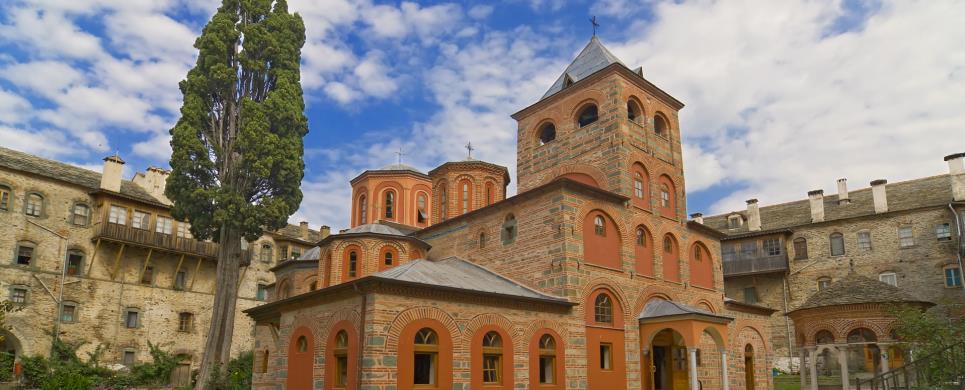
MONI FILOTHEOU (Monastery) AGION OROS
Tel: +30 23770 23256, 23674-9
Fax: +30 23770 23674
The monastery lies in a paltean, a little above the monastery of Karakallou
about 2.5 hrs from Karyes and is dedicated to the Annunciation of the Virgin.
The Katholicon is built shortly before the mid 18th c. and decorated with frescoes
after the mid 18th c. The monastery has eight chapels and 13 kellia, one of them
at Karyes.
The monastery was founded in the last quarter of the 10th c. but only
in the end of the 11th c. takes the form of a monastery. In the end of 13th and
14th c. the monastery receives financial aid by the emperors of Byzantium and
the Serbian rulers. After the fall of the empire, the monastery is financially
supported by the rulers of eastern Europe. In 1871, the monastery with the exception
of the Katholikon, the Refectory and the library, is burnt to the ground.
The monastery owns many heirlooms, holy relics and above all the miraculous
icon of the Virgin Glykophilousa. The library contains 250 manuscripts and many
books.
The monastery is inhabited by a brotherhood of 50 monks.

MONI IVIRON (Monastery) AGION OROS
Tel: +30 23770 23248, 23643-5, 23203
Fax: +30 23770 23248
Third in precedence among the twenty monasteries of the Holy Mountain,
the monastery was built in the end of the 10th century by the Georgian (Iberes)
monks Ioannis and Euthymius in the place where there was before the monastery
of Clement. The 16th century has been a period of prosperity for the monastery,
and, as result, it has been decorated with splendid painting works (the Katholicon
frescoes etc).
Built by the sea, the monastery is surrounded by four aisles, presenting
a rectangular shape. In the center, one sees the central church, founded in the
10th century, as the two historically important chapels, of Panaghia Portaitissa
and of John the Precursor. The largest part of the aisles has been rebuilt during
the 19th century.
A numerous monastic community is in charge of the restoration of the
ruined buildings surrounding the monastery and offers hospitality to scientists
from all the world, who wish to study the historic heirlooms of the monastery.
The monastery΄s feast is on August 15th - day of the dormition of
the Virgin - (August 28th in the New diary) and is celebrated with particular
splendour. Many pilgrims visit the monastery for the legendary miracles of the
Panaghia Portaitissa.
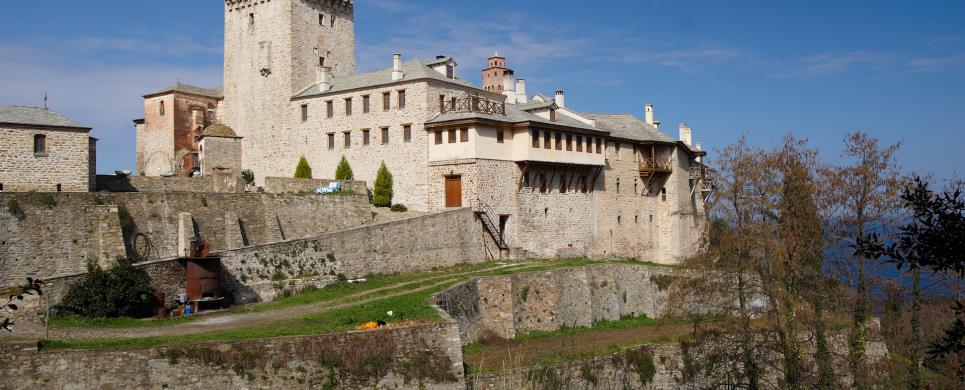
MONI KARAKALOU (Monastery) AGION OROS
Tel: +30 23770 23225, 23279
Fax: +30 23770 23746
The monastery is situated between the monasteries of Great Lavra and
Iviron, on a slope by the sea and is dedicated to St Peter and St Paul. Inside
the fortified enclosure, there is the Katholikon of athonite type, built in mid
16th c. and decorated with frescoes in the early 18th c. The monastery has 7 chapels,
4 Kellia in Karyes, and 14 Kellia in the forest to the S.W. of it.
The monastery is mentioned in documents of 1018 and 1087. In the 13th
c. the monastery is entirely ruined and rebuilt by the emperors Andronic II and
Ioannis V Paleologos. Afterwards the monastery is attacked by Latins and pirates.
In the 16th c. it is completely destroyed and rebuilt with the financial aid of
rulers of Moldavia and Vlachia.
In the monastery, there are many portable icons, holy heirlooms and
ecclesiastical vessels. The library contains 279 manuscripts and about 2,500 books.
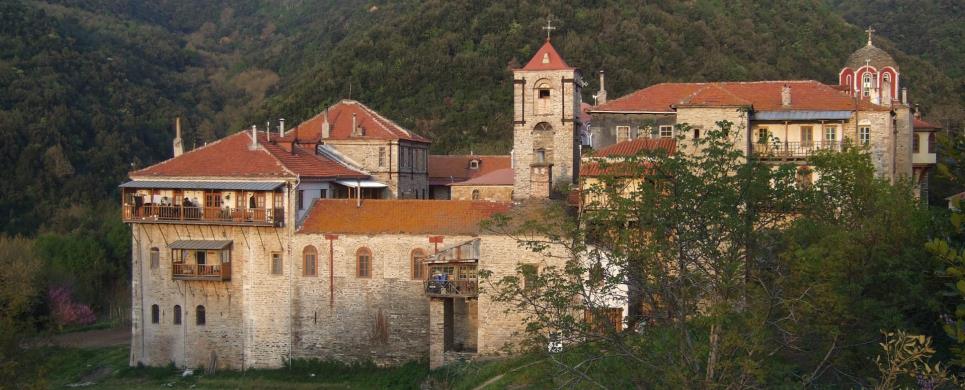
MONI KONSTAMONITOU (Monastery) AGION OROS
Tel: +30 23770 23228, 23278
The monastery is situated between the monasteries of Zografou and Dionysiou,
30 min from the sea, in the side of Siggitikos and is dedicated to St Stephen.
The Katholicon is built after the mid 19th c. following the athonite type, over
the ruins of the old Katholicon. The monastery has 9 chapels.
The first mention of the monastery is from the 11th c. In the early
14th c. it is destroyed. Afterwards, its borders are defined by imperial chrysoboula,
and it is financially supported by Serbian rulers. After the fall of the Empire,
the monastery knows alternatively periods of prosperity and great
Perhaps, the most outstanding of the monastery's heirlooms, are the
portable icons of St Stephen, of Virgin Hodegetria and of Virgin Antiphonetria.
There are also reliquaries, ecclesiastical vessels, chrysoboula and others. The
library contains 110 manuscripts and many books.
The monastery is inhabited by a brotherhood of 30 monks.
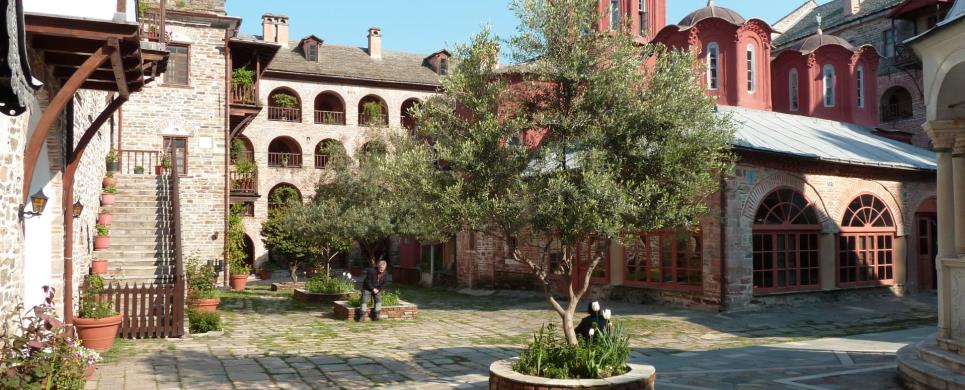
MONI KOUTLOUMOUSSIOU (Monastery) AGION OROS
Tel: +30 23770 23226
Fax: +30 23770 23731
The monastery buildings are set in a rectangular shape with a rather
vast courtyard, with the central church (Katholicon) in its center. The refectory
is presently built a new (1995), while the central church, built in the 16th century,
is covered with five domes and with a glass covered exonarthex.
The original monastery was built before the 12th century but in the
14th centutry, abbot Chariton of Imvros, receeded to the enlargement of the monastery;
during its lifetime vast destructions were caused either by fire or by fall of
rocks.
Apart from the Katholicon frescoes dated in the mid 16th century,
the monastery possesses more than 600 manuscipts, many of which are illuminated,
as well as imporant historic archive and a large number of old printed books.
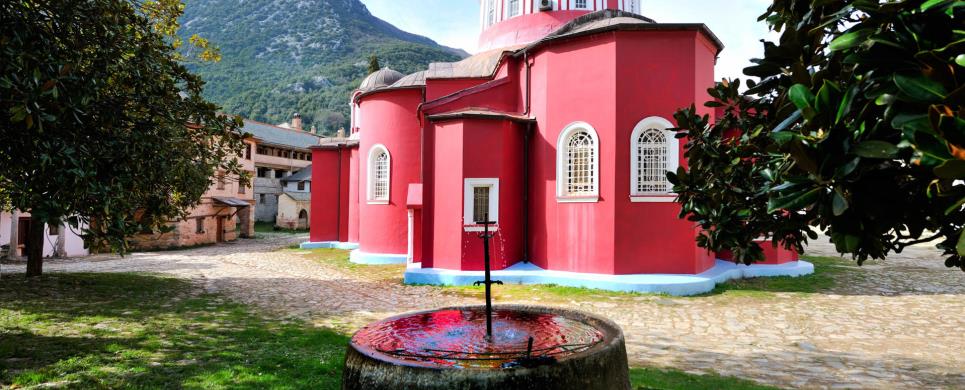
MONI MEGISTIS LAVRAS (Monastery) AGION OROS
Tel: +30 23770 23761, 23277
Fax: +30 23770 23762
It was built in 963 by St. Athanasius the Athonite, with the financial support of the emperors Nikephorus Phocas and Ioannis Tzimiskes. During the ten centuries of its existence, the monastery has always held the first place among the other monasteries of the Holy Mountain, partly because of its wealth, partly because of the heirlooms stored there (manuscripts, historic documents, chrysobulls, portable icons etc).
The monumental structure of the
monastery complex
is particularly noticed in its
large buildings.
The central church (the Katholicon)
with the two large chapels of the Forty Martyrs and of St. Nicholas, occupies the center of the monastery. Within the enclosure, there is also the refectory, the kitchen, the library etc. In the four aisles, which surround the monastery, are the monks cells, the guest-house,
chapels and others.
The monastery is inhabited by 50 monks whose daily occupations are
divided among their monastic duties (mass,prayers etc.) and the hospitality to
the many visitors from all the world.
The monastery remains open throughout the year from sunrise until sunset. During the winter months, it is extremely difficult to reach the monastery. The visitors who wish to study or take photographs of the monastery΄s works of art, must first contact the 10th Ephorate of Byzantine Antiquities as well as the monastery itself.
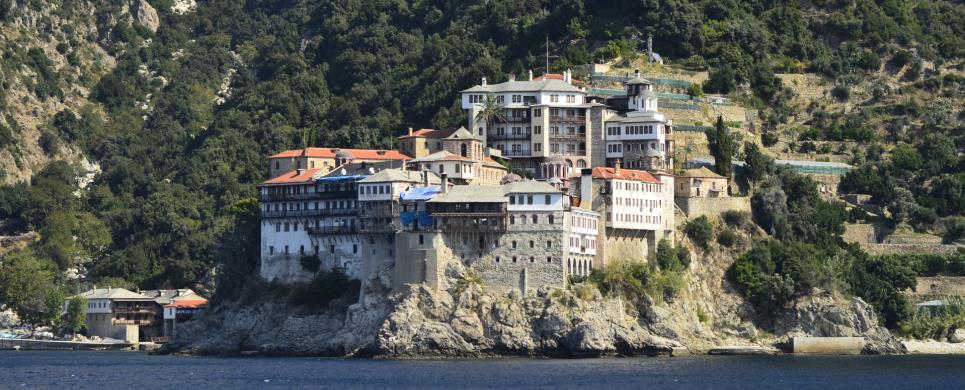
MONI OSSIOU GRIGORIOU (Monastery) AGION OROS
Tel: +30 23770 23218, 23669
Fax: +30 23770 23671
The monastery is built by the sea, in the S.W. side of the peninsula,
between the monasteries of Dionysiou and Simonopetra and is dedicated to St Nicholas.
The Katholicon is built and painted after the mid 18th c. The monastery has 10
chapels and 4 kellia in Karyes.
The monastery is built during the 14th c Afterwards, there is very
little information of it. The Russian pilgrims Barsky (18th c.) reports that the
monastery was restarted in 1500, is the smallest of the monasteries, and almost
all the heirlooms and the documents were lost in the fire of 1761. The monastery
is finally rebuilt with the financial aid of the princes of Moldavia and Valachia.
Inside the Katholicon are kept many heirlooms and portable icons,
the most outstanding of which are those of St Nicholas, of Virgin Galaktotropousa
and of Virgin Pantanassa.
In the library there are 297 manuscripts, about 4,000 books and many
documents.
The monastery is inhabited by a brotherhood of 70 monks.
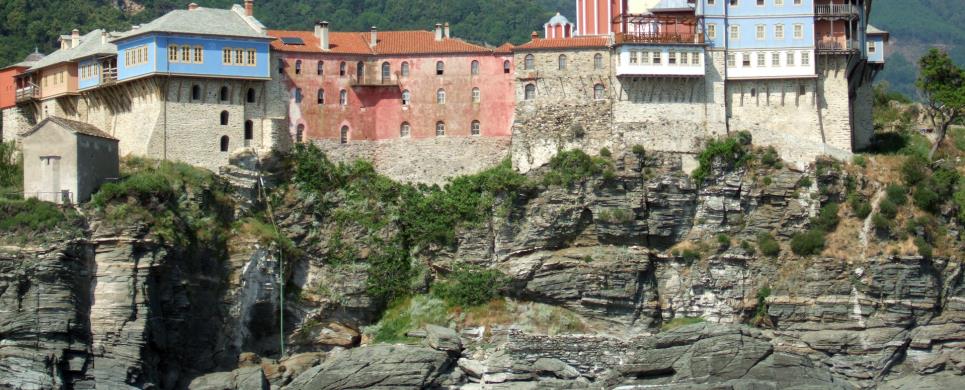
MONI PANTOKRATOROS (Monastery) AGION OROS
Tel: +30 23770 23253, 23685, 23880
Fax: +30 23770 23685
The monastery is built by the sea, in the N.E. side of the peninsula
and is dedicated to the Transfiguration of the Saviour. The Katholicon follows
the athonite type and has frescoes of the 14th c. that were painted over in 1845.
The monastery has 15 chapels, the most important of which is that of the Dormition
of Virgin. Among the Kellia of the monastery, the most important are of the Ravdouchou,
possibly of the 10th c. and the Dormition of the Virgin, named Axion Esti after
the namesake icon. The Skete of Prophet Elias belongs also to the monastery.
The monastery's founders were two byzantine officials, Alexios and
Ioannis, who in mid 14th c. with the support of the emperor Ioannis 5th Paleologus,
transformed their cell into a monastery. After the fall of the empire, the monastery
is financially supported by rulers of eastern Europe. Two destructive fires took
place in 1773 and recently in 1948.
The monastery possesses a large collection of portable icons, ecclesiastical
vessels and heirlooms, while in the library there are 350 manuscripts and over
3,500 books.
The monastery is inhabited by a brotherhood of 25 monks.
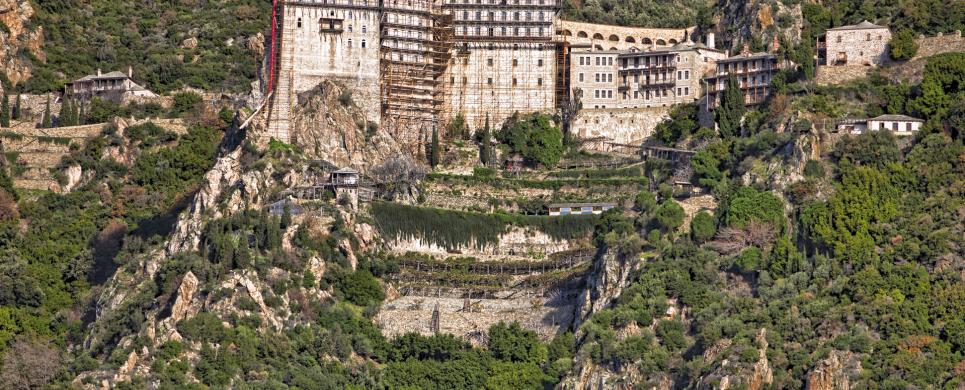
MONI SIMONOS PETRAS (Monastery) AGION OROS
Tel: +30 23770 23254
Fax: +30 23770 21014
The seven-stored monastery of Simonopetra is the most bold construction
of the peninsula, and is dedicated to the birth of Christ. The name comes from
the founder of the monastery, Hosios Simon, who lived in Athos in the mid 14th
c.The Katholicon was built after the last fire and has no frescoes. The monastery
has 15 chapels and 5 Kellia in Karyes.
At the end of 16th c. the monastery is burnt down, rebuilt and reburnt
in the beginning of the 17th c. This long period of decline is interrupted by
shorts periods of prosperity. At the end of the last century, the monastery is
one more time burnt, and rebuilt with funds from Russia.
Among the monastery's heirlooms, the most important is a piece of
Saviour's Cross, holy reliquaries and others. The library, after the last fire,
possesses only a few modern manuscripts and books.
The monastery is inhabited by a brotherhood of 60 monks.

MONI TIMIOU PRODROMOU SERON (Monastery) SERRES
Tel: +30 23210 71189
The Monastery
of Timios Prodromos is located 12 km. NE of Serres, in the bottom of a ravine
on Mt Menoikion. The catholicon (main church) was built in the 14th century and
belongs to the single-aisled domed type with lite, narthex, exonarthex and an
oblong roofed portico on the south side (Makrynariki). On the north side are two
chapels and the belfry. The rest of the buildings are organized around the catholicon:
cells, abbot's quarters, school, refectory, library, hostel. The wall paintings
of the catholicon were executed in 1300-1333 and were continued in several periods,
by various artists.
The monastery was founded in 1275-1278 by monk Ioannikios from Serres
and a few years later it was renovated by his nephew, Ioakeim, bishop of Zichne.
It soon developed to an important monastic centre with great financial prosperity,
because it was favoured by the Byzantine emperors. Patriarch George Scholarios
(Gennadios) died here and was buried in the catholicon.
The monastery, still functioning today, acquired its final form with
the addition of many buildings during the Turkish occupation.
In the years between 1972 and 1986 the roofs of several buildings
were repaired. Since 1986 restoration has been carried out at the cells of the
east wing and at the north wing.

MONI XENOFONTOS (Monastery) AGION OROS
Tel: +30 23770 23249, 23633
Fax: +30 23770 23631
It is built by the sea, between the monasteries of Docheiariou
and St Panteleimonos,
and is dedicated to St George. The Katholicon is built in the early 18th c. and
has no frescoes. In the old Katholicon, there are remarkable frescoes of the Cretan
painter Antonius (1544) as well as the wooden-curved templum of the 17th c. The
monastery possesses 14 chapels, 8 of which are inside the monastery.
The monastery is mentioned for the first time in the last quarter
of the 11th c. Its period of prosperity is interrupted by the fall of Constantinople.
Afterwards, the monastery is alternatively destroyed and rebuilt with the financial
aid from the rulers of eastern Europe.
Among the heirlooms of the monastery, the most prized are the two
mosaic icons with the Transfiguration of Christ, ecclesiastical vessels and others.
In the library there are 300 manuscripts, various documents and over 4,000 books.
The monastery is inhabited by a brotherhood of 35 monks.
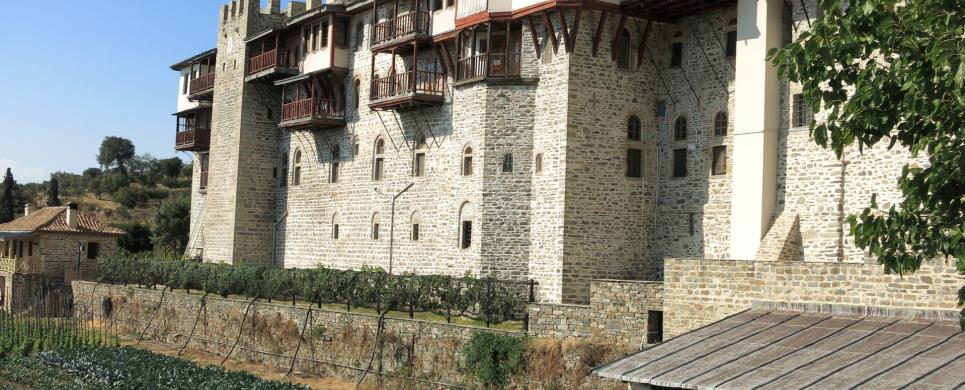
MONI XIROPOTAMOU (Monastery) AGION OROS
Tel: +30 23770 23251, 23733
Fax: +30 23770 23733
The monastery is in the middle of the athonite peninsula, on the way
from Daphne to Karyes and is dedicated to the 40 Martyrs. The Katholicon was built
in 1761 by the monk Caesarius Daponte and decorated with frescoes in 1783. The
monastery has several chapels and a few kellia.
The monastery was founded in the end of 10th c., possibly by the monk
Pavlos Xeropotaminos, and prospered till the Frankish conquest, when it is attacked
and sacked by pirates. In the late Byzantine period it is financially supported
by the Paleologan dynasty as well as Serbian rulers. After the fall of Byzantium,
the turkish raids, and two destructive fires in 1507 and 1609, cause serious damages
to the monastery.
The monastery owns a rich collection of heirlooms, the most outstanding
of which, is the largest in the world piece of the Christ's Cross, as well as
a small round steatite icon, known as the Pulcheria Disk.
The library contains about 400 manuscripts and 4,000 books.
The monastery is inhabited by a brotherhood of 30 monks.
Receive our daily Newsletter with all the latest updates on the Greek Travel industry.
Subscribe now!